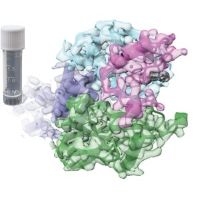Specification
| Description | Recombinant protein from the full-length sequence of Homo sapiens ERCC excision repair 6, chromatin remodeling factor (ERCC6), transcript variant 3 (NM_000124). |
| Organism | Homo sapiens (Human) |
| Expression Host | Human Cells |
| Tag Info | His or DYKDDDDK. Please contact us if you need further information or require specific designed tag. |
| Purity | Greater than 90% by SDS-PAGE gel |
| Uniprot ID | Q03468 |
| Entry Name | ERCC6_HUMAN |
| Gene Names | ERCC6 CSB |
| Alternative Gene Names | CSB |
| Alternative Protein Names | DNA excision repair protein ERCC-6 (EC 3.6.4.-) (ATP-dependent helicase ERCC6) (Cockayne syndrome protein CSB) |
| Application | Antigens, Western, ELISA and other in vitro binding or in vivo functional assays, and protein-protein interaction studies; For research & development use only! |
| Buffer | Purified protein formulated in a sterile solution of PBS buffer, pH7.2, without any preservatives |
| Endotoxin | Endotoxin level is < 0.1 ng/µg of protein (<1EU /µg) |
| Length | 1493 |
| Molecular Weight(Da) | 168416 |
| Protein Sequence | (The sequence of expressed protein may have some variation from the sequence shown below. Please contact us for the exact sequence.) MPNEGIPHSSQTQEQDCLQSQPVSNNEEMAIKQESGGDGEVEEYLSFRSVGDGLSTSAVGCASAAPRRGPALLHIDRHQIQAVEPSAQALELQGLGVDVYDQDVLEQGVLQQVDNAIHEASRASQLVDVEKEYRSVLDDLTSCTTSLRQINKIIEQLSPQAATSRDINRKLDSVKRQKYNKEQQLKKITAKQKHLQAILGGAEVKIELDHASLEEDAEPGPSSLGSMLMPVQETAWEELIRTGQMTPFGTQIPQKQEKKPRKIMLNEASGFEKYLADQAKLSFERKKQGCNKRAARKAPAPVTPPAPVQNKNKPNKKARVLSKKEERLKKHIKKLQKRALQFQGKVGLPKARRPWESDMRPEAEGDSEGEESEYFPTEEEEEEEDDEVEGAEADLSGDGTDYELKPLPKGGKRQKKVPVQEIDDDFFPSSGEEAEAASVGEGGGGGRKVGRYRDDGDEDYYKQRLRRWNKLRLQDKEKRLKLEDDSEESDAEFDEGFKVPGFLFKKLFKYQQTGVRWLWELHCQQAGGILGDEMGLGKTIQIIAFLAGLSYSKIRTRGSNYRFEGLGPTVIVCPTTVMHQWVKEFHTWWPPFRVAILHETGSYTHKKEKLIRDVAHCHGILITSYSYIRLMQDDISRYDWHYVILDEGHKIRNPNAAVTLACKQFRTPHRIILSGSPMQNNLRELWSLFDFIFPGKLGTLPVFMEQFSVPITMGGYSNASPVQVKTAYKCACVLRDTINPYLLRRMKSDVKMSLSLPDKNEQVLFCRLTDEQHKVYQNFVDSKEVYRILNGEMQIFSGLIALRKICNHPDLFSGGPKNLKGLPDDELEEDQFGYWKRSGKMIVVESLLKIWHKQGQRVLLFSQSRQMLDILEVFLRAQKYTYLKMDGTTTIASRQPLITRYNEDTSIFVFLLTTRVGGLGVNLTGANRVVIYDPDWNPSTDTQARERAWRIGQKKQVTVYRLLTAGTIEEKIYHRQIFKQFLTNRVLKDPKQRRFFKSNDLYELFTLTSPDASQSTETSAIFAGTGSDVQTPKCHLKRRIQPAFGADHDVPKRKKFPASNISVNDATSSEEKSEAKGAEVNAVTSNRSDPLKDDPHMSSNVTSNDRLGEETNAVSGPEELSVISGNGECSNSSGTGKTSMPSGDESIDEKLGLSYKRERPSQAQTEAFWENKQMENNFYKHKSKTKHHSVAEEETLEKHLRPKQKPKNSKHCRDAKFEGTRIPHLVKKRRYQKQDSENKSEAKEQSNDDYVLEKLFKKSVGVHSVMKHDAIMDGASPDYVLVEAEANRVAQDALKALRLSRQRCLGAVSGVPTWTGHRGISGAPAGKKSRFGKKRNSNFSVQHPSSTSPTEKCQDGIMKKEGKDNVPEHFSGRAEDADSSSGPLASSSLLAKMRARNHLILPERLESESGHLQEASALLPTTEHDDLLVEMRNFIAFQAHTDGQASTREILQEFESKLSASQSCVFRELLRNLCTFHRTSGGEGIWKLKPEYC |
Background
| Function | FUNCTION: Essential factor involved in transcription-coupled nucleotide excision repair which allows RNA polymerase II-blocking lesions to be rapidly removed from the transcribed strand of active genes (PubMed:20541997, PubMed:26620705, PubMed:16246722). Upon DNA-binding, it locally modifies DNA conformation by wrapping the DNA around itself, thereby modifying the interface between stalled RNA polymerase II and DNA (PubMed:15548521). It is required for transcription-coupled repair complex formation (PubMed:16916636). It recruits the CSA complex (DCX(ERCC8) complex), nucleotide excision repair proteins and EP300 to the sites of RNA polymerase II-blocking lesions (PubMed:16916636). Plays an important role in regulating the choice of the DNA double-strand breaks (DSBs) repair pathway and G2/M checkpoint activation; DNA-dependent ATPase activity is essential for this function (PubMed:25820262). Regulates the DNA repair pathway choice by inhibiting non-homologous end joining (NHEJ), thereby promoting the homologous recombination (HR)-mediated repair of DSBs during the S/G2 phases of the cell cycle (PubMed:25820262). Mediates the activation of the ATM- and CHEK2-dependent DNA damage responses thus preventing premature entry of cells into mitosis following the induction of DNA DSBs (PubMed:25820262). Acts as a chromatin remodeler at DSBs; DNA-dependent ATPase-dependent activity is essential for this function. Remodels chromatin by evicting histones from chromatin flanking DSBs, limiting RIF1 accumulation at DSBs thereby promoting BRCA1-mediated HR (PubMed:29203878). Required for stable recruitment of ELOA and CUL5 to DNA damage sites (PubMed:28292928). Involved in UV-induced translocation of ERCC8 to the nuclear matrix (PubMed:26620705). Essential for neuronal differentiation and neuritogenesis; regulates transcription and chromatin remodeling activities required during neurogenesis (PubMed:24874740). {ECO:0000269|PubMed:15548521, ECO:0000269|PubMed:16246722, ECO:0000269|PubMed:16916636, ECO:0000269|PubMed:20541997, ECO:0000269|PubMed:22483866, ECO:0000269|PubMed:24874740, ECO:0000269|PubMed:25820262, ECO:0000269|PubMed:26620705, ECO:0000269|PubMed:28292928, ECO:0000269|PubMed:29203878}. |
| Pathway | |
| Protein Families | SNF2/RAD54 helicase family |
| Tissue Specificity |
QC Data
| Note | Please contact us for QC Data |
| Product Image (Reference Only) |  |

